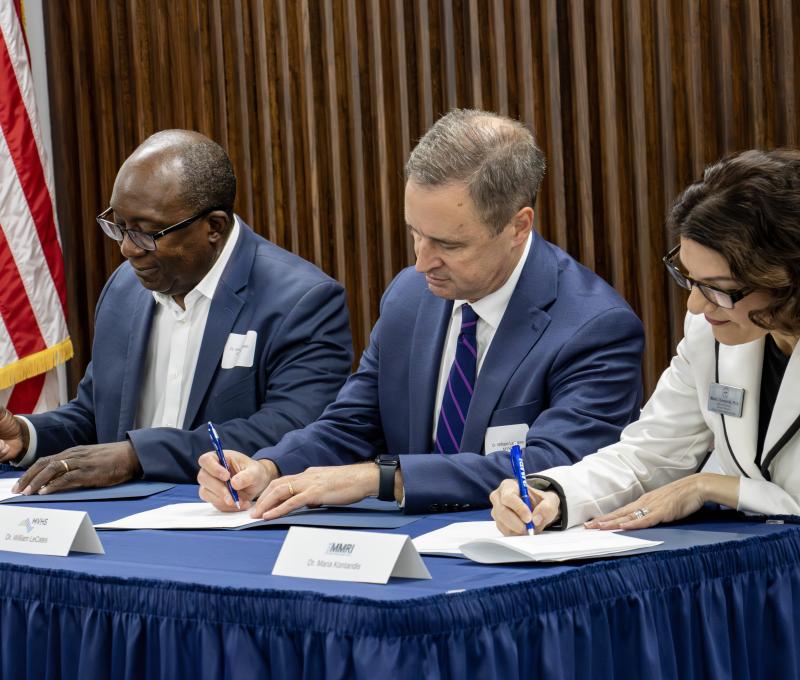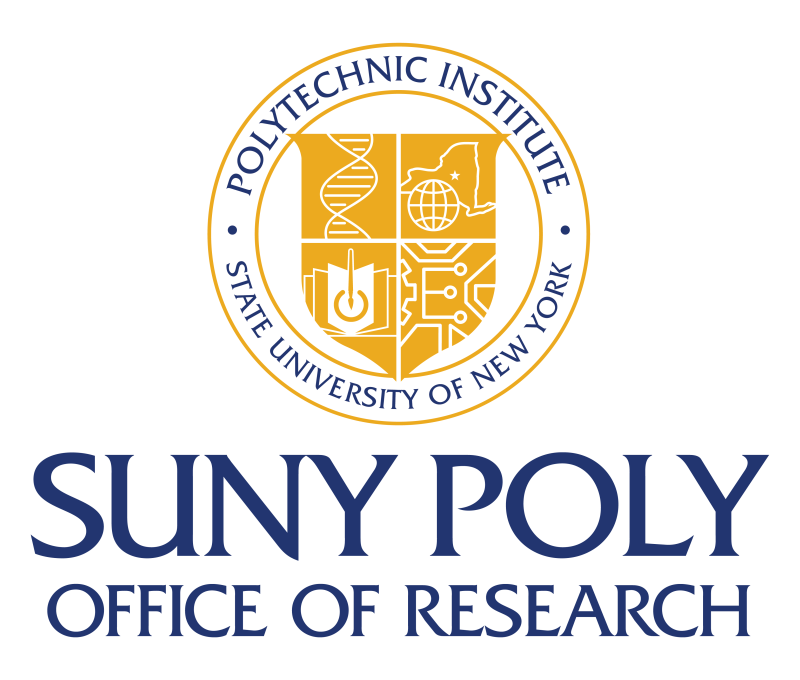National Science Foundation Awards $837,000 to Research Team
National Science Foundation Awards $837,000 to Research Team
Developing Cutting Edge Climate Change Monitoring Technology

For Release: February 5, 2015
Contact: Jerry Gretzinger, Vice President of Strategic Communications and Public Relations
(518) 956-7359 | jgretzinger@sunycnse.com
Revolutionary Device Will Be Embedded in Trees to Track Effects Of Global Warming
Albany, NY – Serving as a testament to the far-reaching impact of Governor Andrew M. Cuomo’s commitment to maintaining New York State’s global leadership in nanotechnology innovation, SUNY Polytechnic Institute’s Colleges of Nanoscale Science and Engineering (SUNY Poly CNSE) today announced the National Science Foundation (NSF) has awarded $837,000 to support development of a first of its kind nanoscale sensor to monitor the effects of climate change on trees. Researchers from SUNY Poly CNSE and the University at Albany are spearheading the project with additional support from the SUNY College of Environmental Science and Forestry (ESF) in Syracuse and Boston University.
“Thanks to the leadership and support of Governor Andrew M. Cuomo, whose extraordinary vision and high-tech blueprint for New York State have enabled unmatched opportunities for nanotechnology innovation, breakthrough technologies such as the NANAPHID are being developed here everyday,” said Dr. Alain Kaloyeros, President and CEO of SUNY Poly. “I extend my congratulations to the research team on this NSF award, which serves as further recognition of New York’s global leadership in nanotechnology research and development, as well as the strength of its world class universities, faculty and staff.”
The NSF grant was generated through the Instrument Development for Biological Research (IDBR) program, which provides funds to develop new classes of devices for bio-related research. The NANAPHID, a novel aphid-like nanosensor, will provide real-time measurements of carbohydrates in live plant tissue. Carbohydrate levels in trees are directly connected to plant productivity, such as maple sap production and survival. The NANAPHID will enable researchers to determine the effects of a variety of environmental changes including temperature, precipitation, carbon dioxide, soil acidity, pests and pathogens. The nanosensor can also provide real-time monitoring of sugar concentration levels, which are of signficant importance in maple syrup production and apple and grape farming.
“The technology for the NANAPHID is rooted in a nanoscale sensor SUNY Poly CNSE developed to monitor glucose levels in human kidneys being prepared for transplant. Our team determined that certain adjustments would enable the sensor to provide similar monitoring for plants, and provide a critical insight to the effects of climate change on the environment,” said Dr. James Castracane, professor and head of the Nanobioscience Constellation at SUNY Polytechnic Institute. “This is a perfect example of the cycle of innovation made possible through the ongoing nanotechnology research and development at SUNY Poly CNSE’s NanoTech Complex.”
"This new sensor will be used in several field experiments on measuring sensitivity of boreal forest to climate warming. Questions about forest response to rising air and soil temperatures are extremely important for forecasting future atmospheric carbon dioxide levels, climate change and forest health,” said Dr. Andrei Lapenas, principal investigator and associate professor of climatology at the University at Albany. “At the same time, we already see some potential commercial application for NANAPHID-type sensors in agriculture, food industry and other fields. Our collaboration with SUNY Poly CNSE has been extremely productive and I look forward to continuing our work together.”
The NANAPHID project began in 2014 with a $135,000 SUNY Research Foundation Network of Excellence grant. SUNY Poly CNSE will receive $400,000 of the NSF award for the manufacturing aspects of the sensor array development and testing. The remaining funds will be shared between Dr. Lapenas and researchers Dr. Ruth Yanai (ESF), Dr. Thomas Horton (ESF), and Dr. Pamela Templer (Boston University) for data collection and analysis.
“With current technology, analyzing carbohydrates in plant tissues requires hours in the lab or more than $100 a sample if you want to send them out. And you can’t sample the same tissue twice, the sample is destroyed in the analysis,” said Dr. Yanai. “The implantable device will be cheap to produce and will provide continuous monitoring of sugar concentrations, which is orders of magnitude better in both cost and in the information provided. Research questions we never dreamed of asking before will become possible, like tracking changes in photosynthate over the course of a day or along the stem of a plant, because it’s a nondestructive assay.”
"I see incredible promise for the NANAPHID device in plant ecology. We can use the sensors at the root tip where plants give sugars to symbiotic fungi in exchange for soil nutrients,” said Dr. Horton. “Some fungi are believed to be significant carbon sinks because they produce extensive fungal networks in soils and we can use the sensors to compare the allocation of photosynthate to roots colonized by these fungi versus the allocation to less carbon demanding fungi. Further, the vast majority of these symbiotic fungi cannot be cultured in lab. These sensors will provide valuable insights into plant-microbe interactions under field conditions.”
“The creation of this new sensor will make understanding the effects of a variety of environmental changes, including climate change, on the health and productivity of forests much easier to measure,” said Dr. Templer. “For the first time, we will be able to measure concentrations of carbohydrates in living trees continuously and in real-time, expanding our ability to examine controls on photosynthesis, sap flow, carbon sequestration and other processes in forest ecosystems.”
####################
SUNY Polytechnic Institute.SUNY Polytechnic Institute (SUNY Poly) is New York’s globally recognized, high-tech educational ecosystem, formed from the merger of the SUNY College of Nanoscale Science and Engineering and SUNY Institute of Technology. SUNY Poly offers undergraduate and graduate degrees in the emerging disciplines of nanoscience and nanoengineering, as well as cutting-edge nanobioscience and nanoeconomics programs at its Albany campus, and degrees in technology, professional studies, and the arts and sciences at its Utica/Rome campus. As the world’s most advanced, university-driven research enterprise, SUNY Poly boasts more than $20 billion in high-tech investments, over 300 corporate partners, and maintains a statewide footprint. The 1.3 million-square-foot Albany NanoTech megaplex is home to more than 3,500 scientists, researchers, engineers, students, faculty, and staff, in addition to Tech Valley High School. The Utica/Rome campus offers a unique high-tech learning environment, providing academic programs in technology, including engineering, cybersecurity, computer science, and the engineering technologies; professional studies, including business, communication, and nursing; and arts and sciences, with degrees and course offerings in natural sciences, mathematics, humanities, and social sciences. Thriving athletic, recreational, and cultural programs, events, and activities complement the campus experience. SUNY Poly operates the Smart Cities Technology Innovation Center (SCiTI) at Kiernan Plaza in Albany, the Solar Energy Development Center in Halfmoon, SUNY Poly CNSE’s Central New York Hub for Emerging Nano Industries in Syracuse, the Photovoltaic Manufacturing and Technology Development Facility in Rochester, and the Smart System Technology and Commercialization Center (STC) in Canandaigua. SUNY Poly founded and manages the Computer Chip Commercialization Center (Quad-C) on its Utica campus and also manages the $500 million New York Power Electronics Manufacturing Consortium, with nodes in Albany and Rochester, as well as the Buffalo High-Tech Manufacturing Innovation Hub at RiverBend, Buffalo Information Technologies Innovation and Commercialization Hub, and Buffalo Medical Innovation and Commercialization Hub. For information visit www.sunycnse.com and www.sunypoly.edu.







